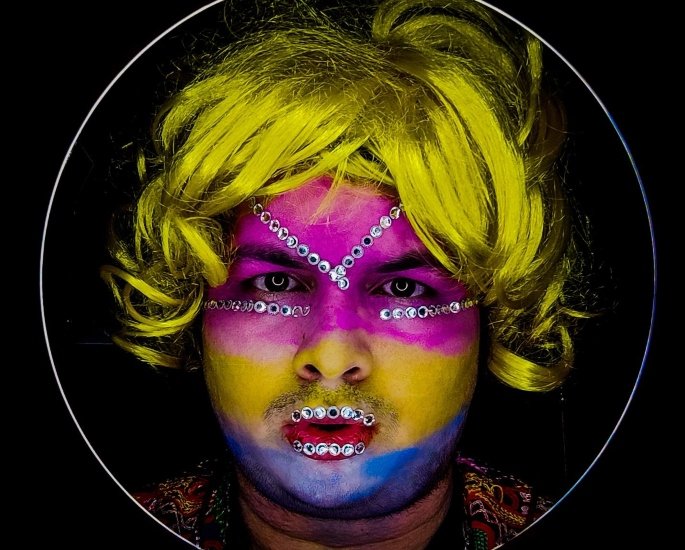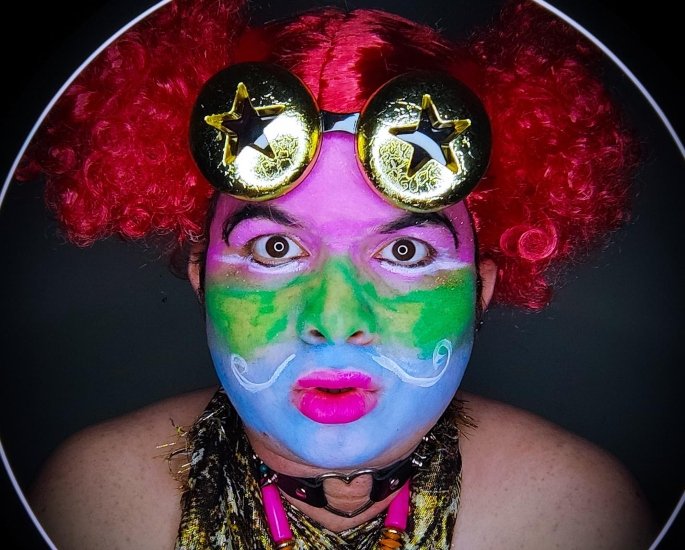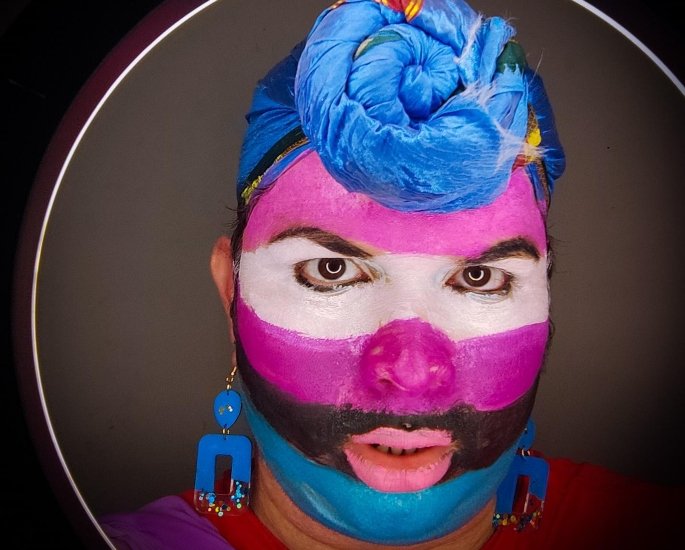Drag Artist Patruni Sastry on Sexuality, LGBTQI & Pride
Patruni Chidananda Sastry is a pansexual drag artist from Hyderabad and tells DESIblitz of their story regarding sexuality in India.
Whilst sexuality is a massive taboo in India and in the South Asian community, Patruni is making active strides in eradicating this stigma.
They want to break down the barriers in how people understand gender and the LGBTQI+ spectrum.
This came in the form of Patruni’s Face of Pride project.
The 30-day process surrounded all elements of the LGBTQI+ community where Patruni painted the flag of each orientation on their face.
They wanted to spread more awareness in the most artistic way, guaranteeing interest and intrigue from those around them, especially in India.
We caught up with Patruni to talk more about their journey in identifying their sexuality, the stigma surrounding LGBTQI+ and the Face of Pride project.
Can you tell us the journey you have taken in regard to sexual identity?


My journey into identifying my sexual identity was not something that was really scandalous.
When I started understanding my sexuality, there wasn’t really a word to it and it took me 21 years to understand that I’m a pansexual person.
When I wanted to tell of my pansexuality, I didn’t have to go through a lot of drama in my household. It was quite natural in explaining the word to people.
Initially, people didn’t understand what exactly pansexuality was.
But slowly and steadily, I tried to explain to them that I’m attracted to everybody, irrespective of their gender. I did get negativity as well as positivity.
The journey of self-identifying was something which was so beautiful. Anything that was around me that was not accepting didn’t hit me.
So that was the journey of identifying who I am.
What kind of challenges did you face growing up?
There’s always this phobia about bisexuality which is quite common, that bisexuality or pansexuality is a ‘phase’ or something which is not continuous.
Sometimes people think that bisexual and pansexual people are perverts and often there’s a blindness of pan-ness in the world.
I think that is one of the challenges when I wanted to come out as a bisexual or pansexual person. I have to explain to people what it exactly is.
Apart from that, there was a lot of ridicule outside of the community because people thought it was something which is not real and that it was fake.
“Sometimes they even thought I was making up a story about my sexuality and gender.”
So, there was always this dismissiveness that was there.
That was a little bit of a problem when I was growing up. I’m also a non-binary person which sometimes eradicates transphobia with the people that are around me.
Sometimes they think a person who is dragging or presenting themselves is not like a man and they ridicule or call names and see drag as quite comical.
Those are some of the challenges I have to face through.
Time and again, I think the spirits of me going ahead and pursuing my identity were really high so I was able to ride it out.
Have you had any hostile encounters with people or backlash online?


I did get backlash online and a lot of trolling as well because I’m a drag performer and married to a heterosexual woman.
Yeah, you heard it right. I’m a bisexual person and I’m married to a heterosexual woman.
So a lot of people started saying ‘you’re using drag for your benefit, you’re earning money out of it’.
They said ‘you are creating something that’s not real’ and ‘you should not be doing drag because you are not gay’.
I used to wake up to random people calling me saying that I should stop doing drag. So, there were a lot of backlashes I would get. I would also get a lot of trolls.
People started trolling me because I have a partner who is a woman and there was a double minority for me to address. It was a little bit of a hard journey.
But I wasn’t able to concentrate on that much because I was just doing drag and I was able to present myself deliberately online.
This noise of backlash was kind of eradicated by itself.
Did you have to hide your identity growing up?
It wasn’t like I was hiding my sexuality.
But initially, when you don’t know about your sexuality or you don’t know about the feeling of being yourself, there are not many times you have people around to have those conversations openly.
So I was facing that situation, for a really long time. I was not understanding or categorising what my feelings were.
There was a lot of qualification of ideas which are coming and going.
“Time and again, I was not given the space to open up about what I’m feeling or what I feel about other people.”
So, those were some of the things that I had to hide because I was not aware of the language or how to put it across.
It’s been around 21 years to just understand how I feel. I’m a gender-fluid person but what exactly is gender fluidity?
In 2018 377 was struck down in India. I just went ahead and said to a newspaper article that ‘I’m a gender-fluid person’.
When I say that I’m a gender-fluid person, the entire community in Hyderabad was unsure because they heard the word for the very first time.
That became a language, that became a space for me to explain to people what I identify as.
Because of the language, I was definitely hiding for a really long time, but it wasn’t suffocating.
I didn’t have a proper idea of coming out, I was quite a crystal clear about how I felt post-2018.
I put it across to people not as if I’m part of something great but just as if it’s a natural conversation.
So I think that had held me in making a better effort to normalise my sexuality and gender to the people I am living with.
Can you tell us more about the Face of Pride project?


So I started the Face of Pride project to give an artistic touch and knowledge about the multiple spectrums of LGBTQI+ people.
Basically what I have done is, I have picked up each flag of one sexuality, painted it on my face and presented it in a photo project.
This was in June 2021 so just post-lockdown. I thought why can’t I use this time to educate people about the multiple sexualities we have in society?
The project is all about how the flags represent queer people. I painted all the flags on my face and was able to capture them in a photo.
So, that is basically the Face of Pride project where I turn my face into my pride, educating people about all the alternative sexualities and genders we don’t find in regular terms.
That was the idea behind the project.
How long did the whole project take and what was your creative process like?
It took me the entire month of June.
My initial thing was to create 30 looks but it didn’t come down to 30, it was majorly around 15-20, which was the target I was able to achieve.
Sometimes, it was really easy because it was just a flag I needed to paint but sometimes I wanted to give it a little bit of an artistic touch.
And each one needed to be different from one that I have done. So it was always how I wanted to interpret it.
Apart from the face which needed to be painted, it was how the other things contribute to the idea of sexuality, which was something really important for me.
That was something where I thought okay I need to take this in a far more serious way.
My creative process was to use a lot of face paint because I haven’t used it before.
This project was dependent completely on face paint and how I was able to use painting as a technique to change the face or bring it out.
“One of my favourite ones is the polyamorous look which was green, pink and blue.”
I was able to create this aesthetic of neo-diva which was able to transcend [the look].
I really loved the process. It was a 30-day process and took me two or three days to write about the project.
I always have this idea of writing things about whatever I create. I tried to create it as a journal so I was able to keep it in my memoirs.
What kind of reaction have you gotten?


I did get a lot of good reactions from drag performers.
They would say ‘this is a really wonderful look’. There were a lot of trolls as well. They’d say ‘oh it looks as if a five-year-old has painted your face’.
Those were some of the kinds of negative comments I would get. But I was getting a lot of positive responses.
There were a lot of people who didn’t know about sexualities like pomosexual gender.
When I painted and put that particular sexuality as a label on my project, people were able to get back to me and say ‘oh I identify as this person because I haven’t heard this word’.
So, the word was something which was really important for me.
These are some of the positive reactions I see which made this project so successful.
What does drag mean to you and what barriers need to be broken down?
Drag for me is activism.
A way where you show drag and articulate situations which are there in this particular society.
I don’t have to hold up a placard. I would be able to just paint my face and be the idea of what the new generation requires.
“Therefore, I can educate people by just being myself, so that is something which is drag for me.”
It’s a way of activism which I can put across my face and walk and that itself normalised it for a lot of people.
So it’s a form of art that I use as an activism tool to talk and educate people about atrocities or labels that are happening within society.
What is the state of the LGBTQ/queer community in India?


So the state of the LGBTQI+ community in India is definitely progressing but there is still a long way to go.
There are still transgender people getting killed on the road.
There are still a lot of atrocities happening to queer women and a lot of atrocities happening to those who come from the bispectrum. It’s definitely not a good space.
We are all fighting together, we are all trying to push the bucket forward.
We are still unsure whether 377 is struck down completely or if there is still a way of getting around it.
So, that is the situation of the rights in India. I think it will get better as and when we go forward.
How can South Asian countries/people be more knowledgeable about different sexual identities?
I think the best thing to do is to use Google search because that’s the easiest way and to also put it in conversation on a daily basis.
We should question why we can’t educate people on the LGBTQI+ spectrum.
“Why can’t there be a curriculum that would educate people about it?”
Why can’t the conversations be more natural and normal? That is something which needs to be done.
It’s a constant idea of learning about humanness.
It’s not something which is exported from another country, it’s there and part of the culture, part of the air that we’re all breathing, it’s just natural.
So I think people have to make that little bit of effort to go ahead and understand more about it.
Once they understand it, things will become easier.
As Patruni said, there are much wider discussions and awareness to be had in order for more progress to be made in South Asian communities.
However, projects like Face of Pride should accelerate the conversation around LGBTQI+.
Patruni’s bravery and open nature to talk about their experiences with sexuality are refreshing and eye-opening.
These stories should hopefully spark a change amongst people across the world.